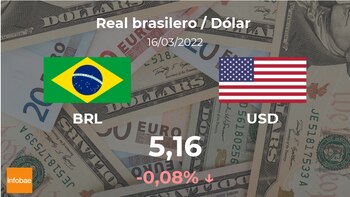
At the
beginning of the day, the US dollar was trading at 5.16 Brazilian Real, which was 0.08% compared to 5.16 Brazilian Real on the previous day.
Taking into account last week's data, the US dollar rose 2.93%. However, it has fallen 7.41% over the course of the year.The three-day trend ends in relation to the past day.In relation to last week's volatility, it represents a lower return than the volatility reflected in last year's figures, which shows that prices are changing less than normal in recent days.
Last year, the US dollar reached a maximum of 5.71 Brazilian reais, and the lowest level was 5.01 Brazilian reais. The US dollar is closer to the minimum value than the maximum.
Thecrisis of Brazilian
real,or Brazilian real, known internationally, is a legal tender in Brazil, the 20th most circulating currency in the world, and second only to the Mexican peso in Latin America.
The actual, which has been in force since 1994, has replaced “cruzeiro real”, and its abbreviation is BRL. It is also the fourth most traded currency on the US continent, after the US dollar, the Canadian dollar, and the Mexican peso.
One of the events that most marked the Brazilian currency was in 1998, when the real was subjected to a strong speculative attack, causing devaluation the following year, increasing from 1.21 to 2 reais per dollar.
Today, there are copper coins of 1 cent and 5 cents, bronze coins of 10 cents and 25 cents, and cupronized coins of 50 cents.The real coin is bimetal. It should be noted that the penny was suspended in 2005, but it is still a legal tender.
On theeconomic side, the International Monetary Fund (IMF) reduced Brazil's growth by 1.7 percentage points in 2022, especially due to the deterioration of the global situation between high inflation and the COVID-19 pandemic.
Brazil's economy, the largest in the Latin American region, entered a recession in the second quarter of 2021 and is expected to stagnate throughout 2022.
Because of COVID-19, Brazil had to pay more with economic stimulus measures (about 12% of GDP) to cope with the pandemic, which ultimately led to a budget deficit for 2022.
Agencies
Últimas Noticias
Debanhi Escobar: they secured the motel where she was found lifeless in a cistern

The oldest person in the world died at the age of 119

Macabre find in CDMX: they left a body bagged and tied in a taxi
The eagles of America will face Manchester City in a duel of legends. Here are the details

Why is it good to bring dogs out to know the world when they are puppies




